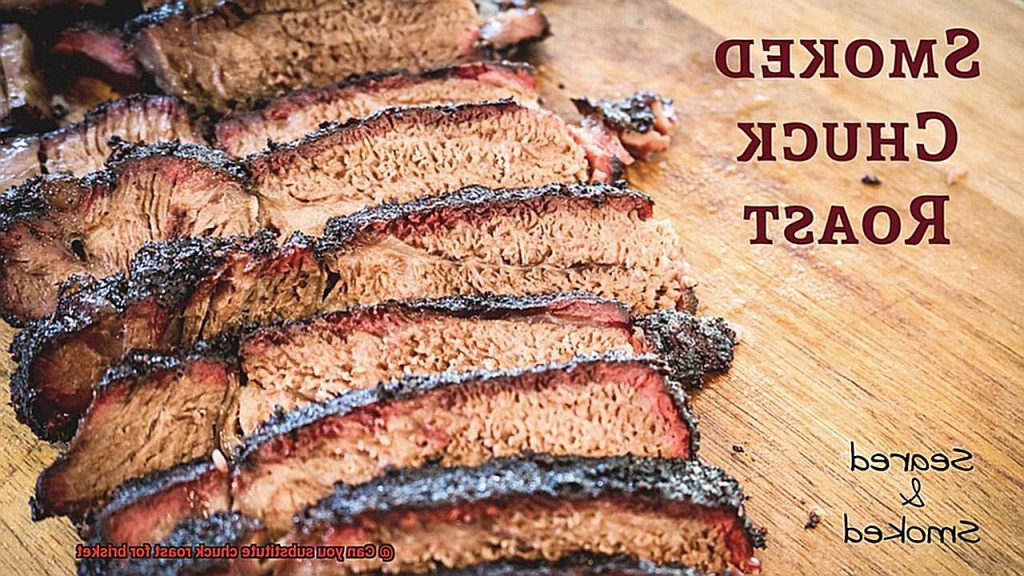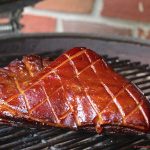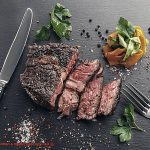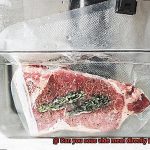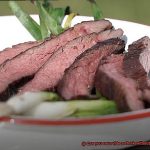Picture this: a sizzling barbecue, the tantalizing aroma of slow-cooked meat wafting through the air. It’s a scene that often calls for one thing – brisket. This tender, flavor-packed cut has earned its place in culinary folklore. But what if you’re left brisket-less? Fear not. Today, we’re unraveling the meaty conundrum of substituting chuck roast for brisket.
In this blog post, we’ll dive deep into the world of meat substitutions, exploring whether chuck roast can hold its own as a stand-in for brisket. Whether you’re an adventurous home cook or aspiring pitmaster, understanding the similarities and differences between these cuts is key to ensuring your dish still hits all the right notes.
Join us on this flavorful journey as we compare marbling, fat content, cooking techniques, and more. By the end, you’ll have both the knowledge and confidence to rock a chuck roast substitution without sacrificing flavor or texture.
So, let’s fire up those grills and get ready to settle the age-old debate: chuck roast vs. brisket – who will come out on top?
Contents
What is Brisket?
Originating from the lower chest area of a cow, it boasts a rich flavor, tenderness, and versatility that elevate any barbecue experience. Whether you’re a fan of Texas-style barbecue or simply looking to take your grilling game to new heights, understanding the ins and outs of brisket is essential.
In this article, we’ll delve into the characteristics of brisket and explore why it holds such a revered place in the world of barbecue.
The Anatomy of Brisket:
At the heart of brisket lies its captivating anatomy. Comprised of two main muscles, the flat and the point, this cut offers a perfect balance of tenderness and flavor when cooked with finesse. The flat, also known as the lean muscle, stretches long and lean with minimal fat marbling throughout. Meanwhile, the point muscle is thicker and more marbled, infusing the brisket with extra juiciness and an explosion of flavor.
Cooking Methods:
To truly unlock the potential of brisket, slow-cooking for several hours is key. This patient approach allows the connective tissues within the meat to break down, resulting in a tender texture that melts in your mouth. This method is deeply embedded in barbecue culture, particularly in Texas-style barbecue where brisket reigns supreme.
However, brisket can also be braised, smoked, or roasted to achieve delectable results. The choice of cooking method depends on personal preference and desired flavors.
Seasonings and Flavors:
Brisket serves as a blank canvas for flavor exploration. Enhance its natural richness with a variety of seasonings to create a flavor profile that tantalizes the taste buds.
A classic dry rub consisting of salt, pepper, paprika, garlic powder, and onion powder is often used to create a robust foundation. For those seeking a smoky dimension, the addition of wood chips like hickory or mesquite during smoking imparts an extra layer of depth to the meat.
Texture and Fat:
The pinnacle of a perfectly cooked brisket is its tender and juicy bite. The texture can range from tender to slightly chewy, depending on personal preference. It’s worth noting the presence of a fat cap on one side of the brisket.
While this fat cap aids in keeping the meat moist during cooking, it can be trimmed off if desired. However, many grill enthusiasts opt to leave some of the fat intact, as it contributes to the overall flavor and succulence of the final dish.
What is Chuck Roast?
If you’re looking to elevate your grilling game, then it’s time to dive into the exquisite world of chuck roast.
Sourced from the shoulder area of the cow, this cut of beef is a hidden gem that can transform any backyard barbecue into a culinary extravaganza. Brace yourself for the rich flavor and tenderness that chuck roast brings to the grill.
Chuck Roast: The Flavorful Marvel
Chuck roast is obtained from the shoulder area, nestled between the neck and forelimb of the cow. Its well-marbled fat content contributes to its succulent texture and imparts a robust flavor that is sure to tantalize your taste buds. The marbling of fat keeps the meat moist during cooking, resulting in juicy and tender bites that will leave you craving more.
Slow-Cooking Magic: Pot Roasts and Beyond
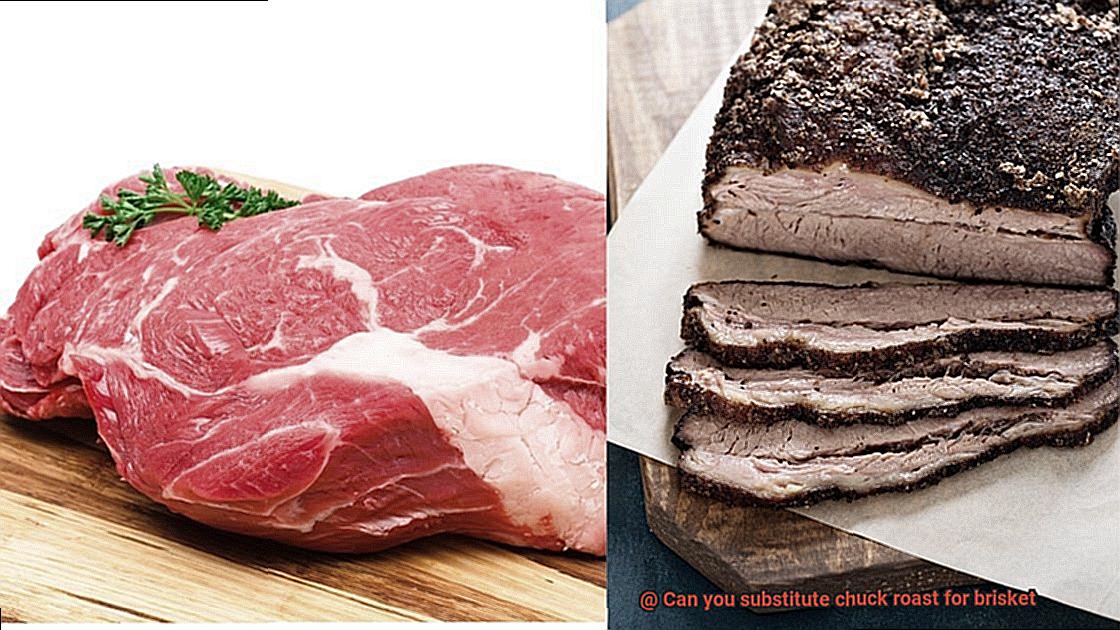
Chuck roast truly shines when cooked slowly using methods like braising or stewing. The connective tissues present in this cut work their magic as they break down during slow cooking. This process results in melt-in-your-mouth tenderness that will make you forget about anything else on your plate.
The rich flavors from the connective tissues also create a luscious sauce or gravy that complements the meat perfectly, adding an extra dimension of deliciousness.
Size Matters: Perfect for Feeding a Crowd or Meal Prep
Chuck roast’s rectangular shape and generous size make it ideal for feeding a group or for meal prepping. It provides ample portions, ensuring everyone at your gathering leaves satisfied and content. Whether you’re hosting a backyard barbecue or planning meals for the week ahead, chuck roast has got you covered. You can find it boneless or bone-in, with the latter option adding an additional depth of flavor during cooking.
The Brisket Substitute
While chuck roast may not have the same level of fattiness as brisket, it can still yield tender and flavorful results when cooked low and slow. In certain recipes, chuck roast can be an excellent substitute for brisket, offering a budget-friendly alternative without compromising on taste. Adjust the cooking method and time accordingly, as chuck roast tends to cook faster due to its higher fat content.
Comparing Brisket and Chuck Roast
When it comes to grilling, beef is king, and two cuts that often steal the show are brisket and chuck roast. These meaty marvels bring their own unique flavors, textures, and tenderness levels to the table. As a grilling expert, I’m here to guide you through the differences between these cuts and help you decide which one will reign supreme on your grill.
Flavor Profiles:
Brisket:
- Known for its rich, beefy flavor that is hard to resist.
- The marbling in brisket adds a succulent juiciness that pairs perfectly with smoky flavors.
- Delivers a mouthwatering taste that is ideal for barbecue enthusiasts.
Chuck Roast:
- Boasts a delightful beef flavor, leaning slightly towards a stronger taste.
- Offers an affordable option for those on a budget.
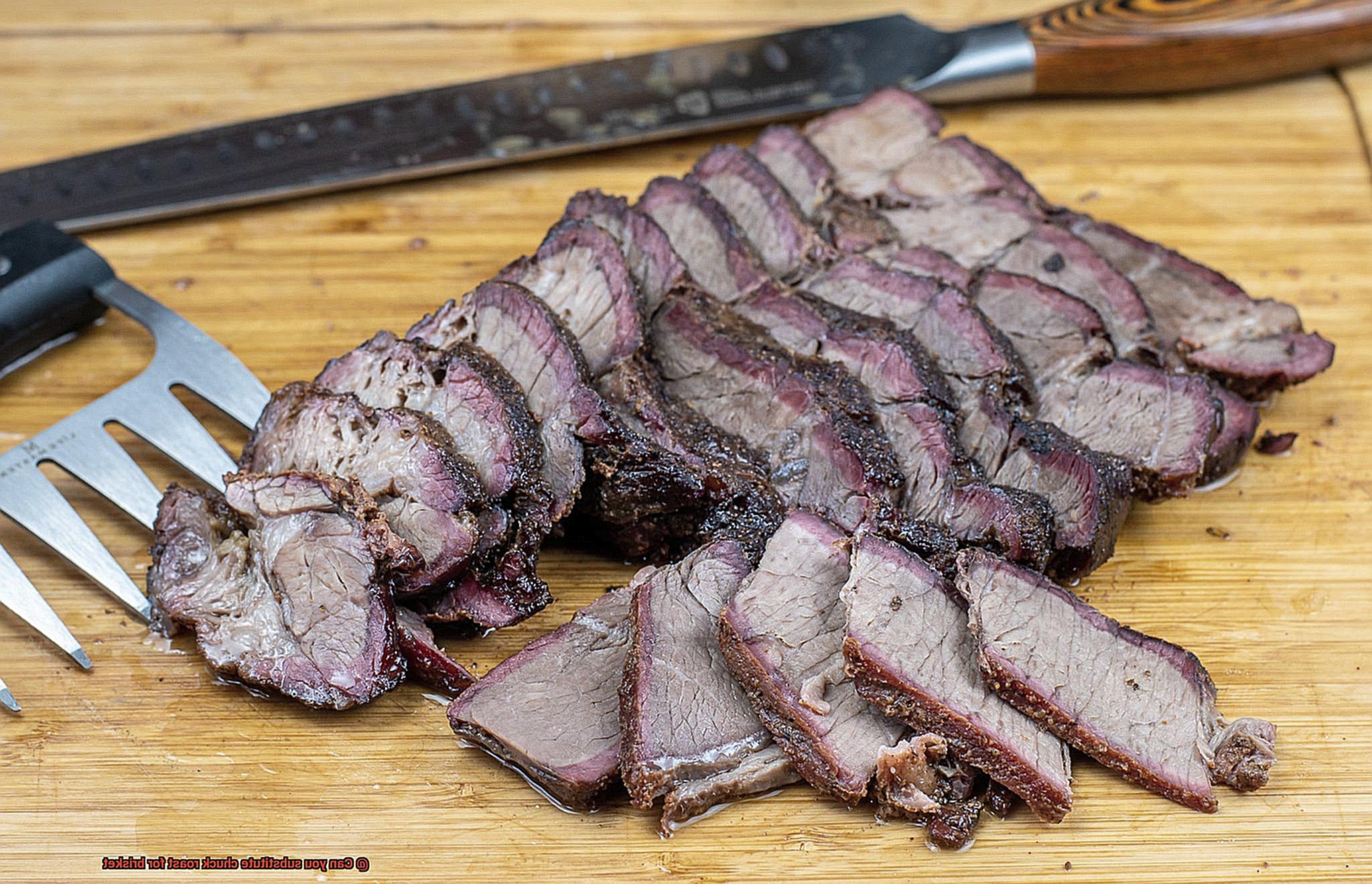
Texture Differences:
Brisket:
- When cooked low and slow, brisket becomes a tender masterpiece with a melt-in-your-mouth texture.
- The marbling ensures a moist and juicy bite.
Chuck Roast:
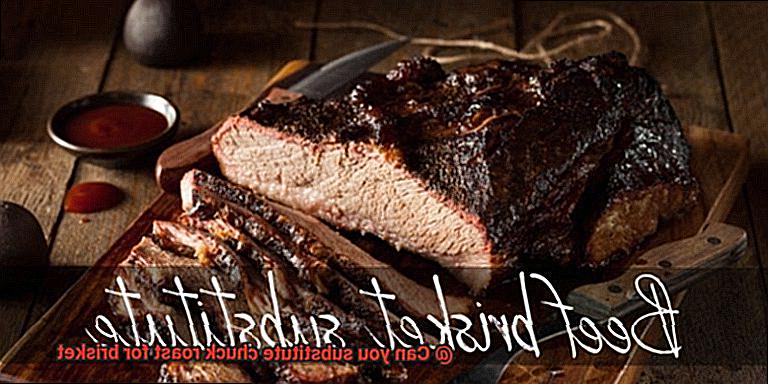
- Contains more connective tissue, which can make it tougher if not cooked properly.
- Rewards patience with a tender and succulent texture once the tissues break down.
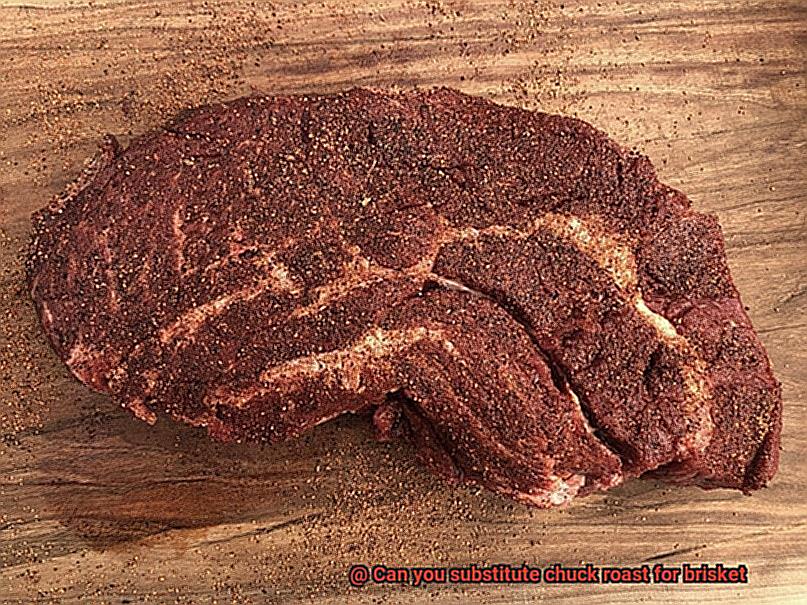
Tenderness Levels:
Brisket:
- The undisputed champion of tenderness when cooked properly.
- Practically falls apart with every bite, thanks to ample time for collagen to break down into gelatin.
Chuck Roast:
- While not as naturally tender as brisket, chuck roast has the potential to reach similar levels of tenderness when cooked with patience and care.
Best Cooking Methods:
Brisket:
- Preferred cooking method is smoking or barbecuing.
- Slow-cooking over indirect heat with wood chips produces the iconic smoky flavor and tender texture.
Chuck Roast:
- Can also be grilled but benefits from marinating or braising prior to grilling.
- Breaking down the connective tissues ensures a more tender result on the grill.
Possible Substitutions:
- Brisket and chuck roast can sometimes be used interchangeably in recipes, but adjustments may be needed to account for differences in cooking times and techniques.
- When substituting chuck roast for brisket, consider marinating or braising the chuck roast to enhance tenderness.
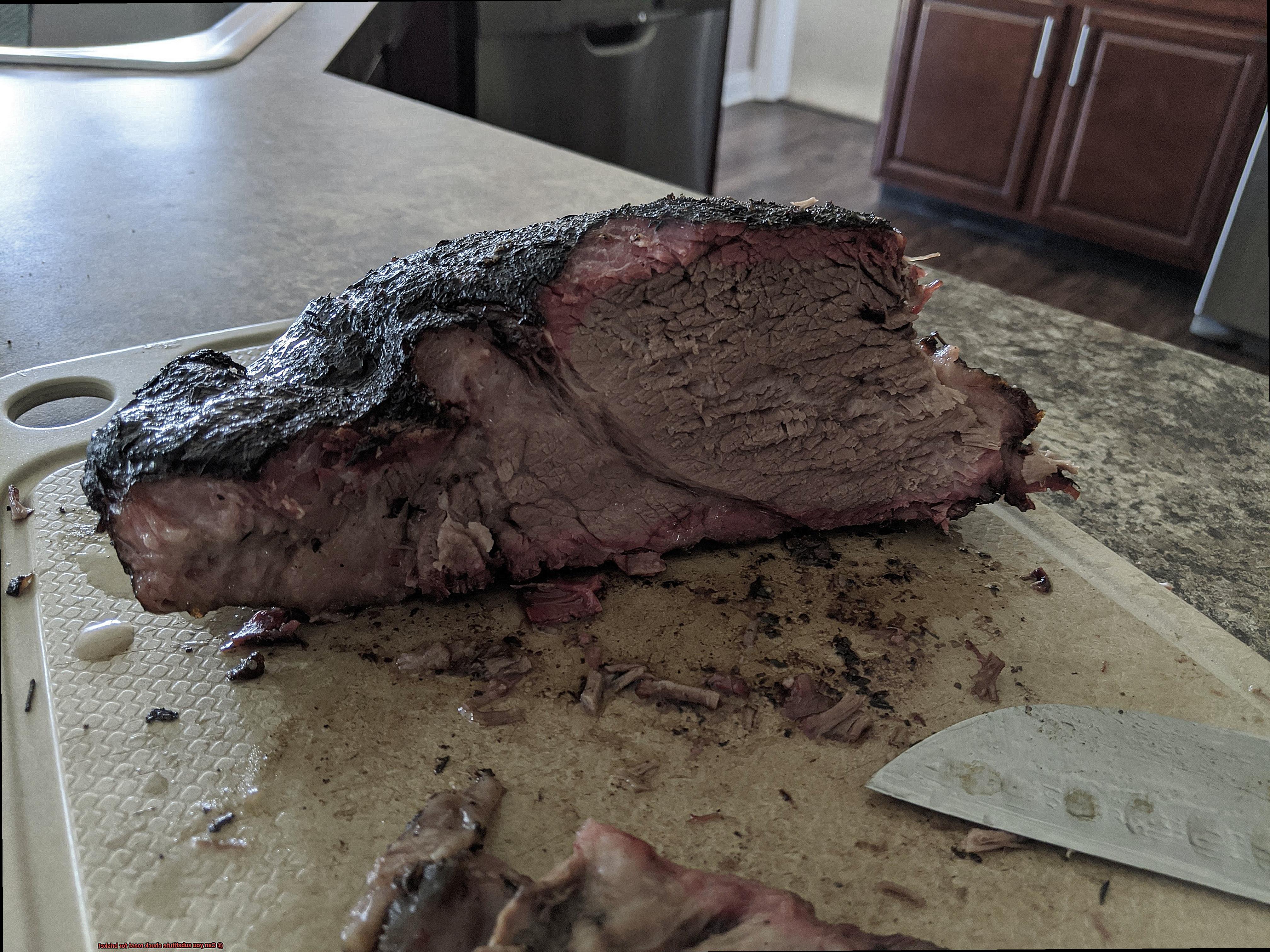
Fat Content Differences between Brisket and Chuck Roast
In the world of grilling, two cuts of beef stand out for their tenderness and flavor: brisket and chuck roast. These cuts offer a delightful eating experience, but they differ significantly in terms of fat content.
Whether you’re a seasoned pitmaster or a backyard grilling enthusiast, understanding the fat content disparities between brisket and chuck roast can help you make informed decisions about cooking methods and flavor profiles.
Join me as we delve into the intricate world of fat content differences that make these cuts unique in their own right.
The Cuts:
Brisket, derived from the lower chest area of the cow, boasts a well-earned reputation for its high fat content. In contrast, chuck roast is sourced from the shoulder or neck region and possesses a more moderate amount of fat.
Marbling:
Marbling, the intricate network of fat that runs through meat, is a key factor in flavor and tenderness. Brisket is heavily marbled, with delicate lines of fat crisscrossing throughout the meat. This intricate marbling enhances its rich flavor profile and ensures moistness during cooking.
On the other hand, chuck roast has less marbling but still contains enough fat to enhance flavor and tenderness.
Fat Distribution:
While brisket’s marbling tends to be concentrated in specific areas, chuck roast exhibits a more even distribution of fat throughout the meat. This even distribution facilitates more consistent cooking and texture, resulting in a melt-in-your-mouth experience.
Flavor and Tenderness:
Brisket’s higher fat content renders it incredibly flavorful and tender when cooked low and slow. The fat breaks down during cooking, infusing the meat with succulence that tantalizes taste buds. Chuck roast offers a leaner alternative with a slightly less fatty taste, appealing to those who prefer a lighter beef flavor without sacrificing tenderness.
Cooking Considerations:
When substituting chuck roast for brisket in a recipe, it’s crucial to account for the fat content disparity. Chuck roast may require additional moisture or marinades to prevent drying out during cooking. However, it proves to be an excellent choice for slow cooking or braising methods, transforming into tender and flavorful meat that is ideal for sandwiches or stews.
Nutrition:
The higher fat content in brisket contributes to its higher caloric value compared to chuck roast. However, both cuts provide a good source of protein, as well as essential nutrients such as iron, zinc, and B vitamins.
Cooking Method Considerations for Substituting Chuck Roast for Brisket
Today, we embark on a culinary adventure where we explore the art of substituting chuck roast for brisket on the grill. As we delve deeper into this topic, we will uncover the secrets behind marinating, seasonings, temperature, cook time, and other factors that come into play when making this substitution. So, grab your aprons and tongs, because it’s time to elevate your grilling game.
Understanding the Cut:
Chuck roast and brisket hail from the same region of the cow – the chest and shoulder. However, they differ in texture and characteristics. Brisket is renowned for its tough connective tissues that transform into melt-in-your-mouth goodness when slow-cooked or smoked. On the other hand, chuck roast boasts more marbling and fat content, resulting in a juicier and flavorful end product.
Adjusting Cook Time and Temperature:
Due to its higher fat content, chuck roast tends to cook faster than brisket. To achieve that perfect tenderness, it’s crucial to monitor the internal temperature. Consider adjusting your cook time accordingly, ensuring your chuck roast reaches its peak deliciousness without drying out.
Tenderizing Techniques:
To mimic the tenderness of brisket when using chuck roast, consider braising or cooking at a lower temperature for a longer duration. This technique helps break down the connective tissues and renders a tender final product that rivals the succulence of traditional brisket.
Flavor Profile:
While chuck roast offers its own delicious beef flavor, it may lack the same depth and smokiness as brisket. Fear not, intrepid griller. You can enhance the flavor by adding liquid smoke or utilizing a smoker to infuse that tantalizing smoky undertone. Experiment with different wood chips or seasonings to create a flavor profile that will leave your taste buds begging for more.
Marinating and Seasonings:
Marinating is an excellent way to introduce flavors to your chuck roast. Opt for marinades that complement the beefy richness of the cut, such as soy sauce, Worcestershire sauce, garlic, and spices like paprika or cumin. Allow the meat to marinate for at least a few hours or overnight, ensuring maximum flavor penetration. This step ensures that every bite of your chuck roast is bursting with mouthwatering flavors.
Flavor Considerations when Substituting Chuck Roast for Brisket
Today, we delve into the tantalizing world of flavor considerations when substituting chuck roast for brisket. Brace yourself for a mouthwatering journey that will impress your friends and leave your taste buds begging for more.
Let’s start by exploring the flavor differences between these two beefy contenders. Brisket, oh brisket. Known for its rich, beefy flavor and a texture so tender it melts in your mouth. The perfect balance of marbling adds juiciness and depth to every heavenly bite. Chuck roast, on the other hand, boasts a slightly bolder beef flavor and tends to be more fatty. Don’t be fooled, though, chuck roast still delivers on the deliciousness front.
Now, when substituting chuck roast for brisket, you must consider how these flavor variations will impact your culinary masterpiece. If your goal is to replicate that signature brisket taste, unleash your creativity by adding extra seasoning or spices to enhance the chuck roast’s flavor profile. Picture smoked paprika, garlic powder, onion powder, or even a delectable BBQ rub. These flavorful additions will help recreate that smoky and savory goodness we all crave.
Ah, cooking methods. Low and slow is the sacred mantra for both brisket and chuck roast. This slow-cooking technique allows the connective tissues to break down and work their magic, resulting in tender perfection. Fear not, chuck roast can also benefit from this method as it helps render the fat and tenderize the meat. Just keep a watchful eye because chuck roast has more fat than brisket, and we don’t want it to turn into a greasy catastrophe.
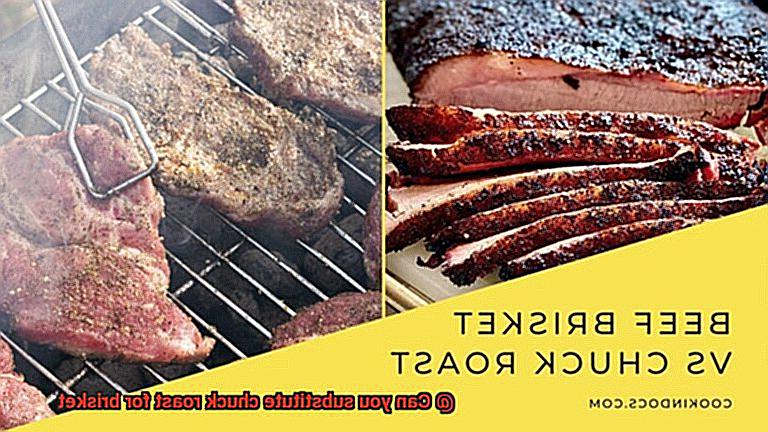
One of the undeniable advantages of chuck roast is its affordability. It often comes with a lower price tag than brisket, making it an excellent option for those who want to savor that luscious beefy taste without emptying their wallets. And that extra fat content in chuck roast? It’s a ticket to juiciness heaven when cooked to absolute perfection.
Now, here’s the scoop. While chuck roast can flawlessly substitute brisket in many recipes, there might be dishes where the flavor and texture differences are more discernible. Purists of traditional Texas-style smoked brisket might yearn for that unmatched level of smokiness and tenderness. Fear not, my friends. Chuck roast shines brilliantly in other culinary adventures such as pot roasts, stews, or mouthwatering shredded beef sandwiches.
Texture Considerations when Substituting Chuck Roast for Brisket
Texture is a critical factor to consider when substituting chuck roast for brisket on the grill. The difference in texture between these cuts can significantly impact the outcome of your barbecue experience. Brisket is famous for its tender and juicy texture, thanks to its higher amount of connective tissue that breaks down during cooking, resulting in a melt-in-your-mouth sensation. On the other hand, chuck roast has less connective tissue and tends to be tougher.
Why does texture matter? Imagine sinking your teeth into a succulent slice of brisket, only to be met with resistance and chewiness. It just doesn’t hit the spot, does it? The texture affects the overall enjoyment of your meal and can elevate or detract from the flavors you’ve worked so hard to infuse into your meat.
To bridge the gap when substituting chuck roast for brisket, there are several techniques you can employ:
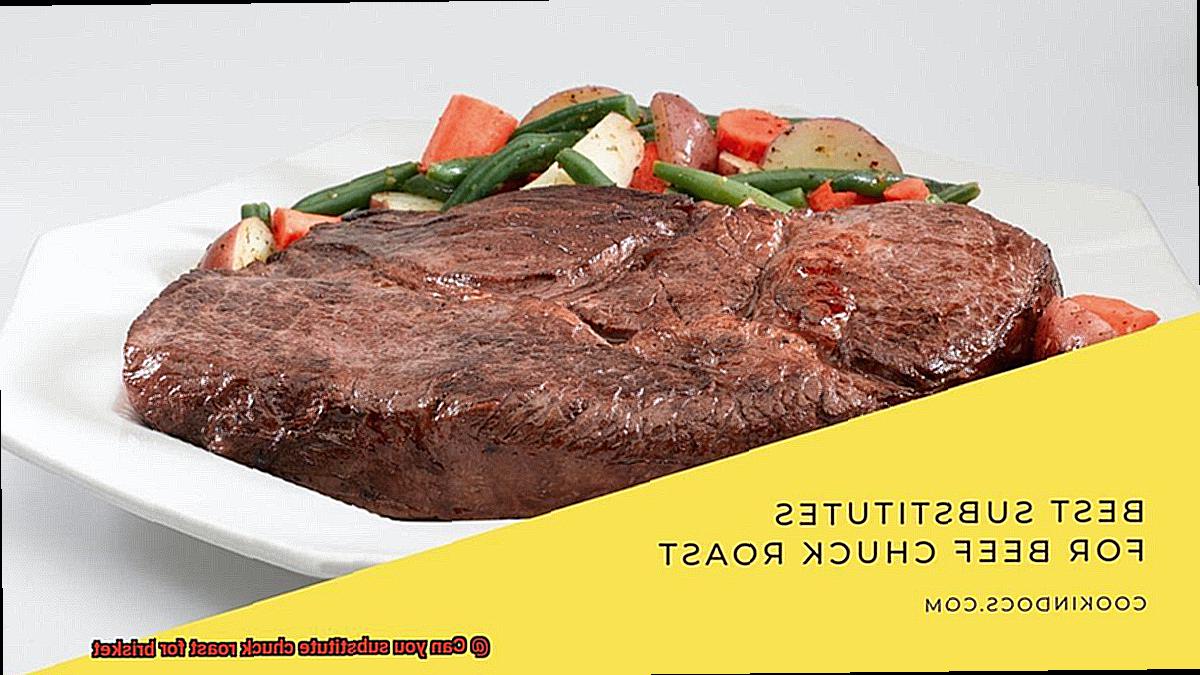
- Low and slow cooking: Just like with brisket, cooking your chuck roast low and slow allows those pesky connective tissues to break down, resulting in a more tender outcome. This method requires patience, but the wait is well worth it when you achieve that perfect texture.
- Marinating: Giving your chuck roast an overnight soak in a flavorful marinade can help tenderize the meat. Ingredients like vinegar, citrus juice, or tenderizing enzymes work wonders in breaking down muscle fibers and creating a more tender texture.
- Meat tenderizer or pounding tool: If you’re really determined to achieve that brisket-like texture, consider using a meat tenderizer or pounding tool. By physically breaking down the muscle fibers, you can achieve a more desirable mouthfeel similar to brisket.
It’s important to keep in mind that while these techniques can improve the texture of chuck roast, it may still have its own unique mouthfeel. Chuck roast will never be an exact replica of brisket, but with the right techniques, you can get pretty close.
Tips for Making the Most of Chuck Roast as a Substitute for Brisket
When it comes to grilling and barbecuing, brisket often takes center stage. However, if you find yourself without a brisket, don’t despair. Chuck roast can be an excellent substitute, with its similar qualities of marbling and connective tissue. By following these tips, you can make the most of chuck roast and still enjoy a flavorful and tender meal.
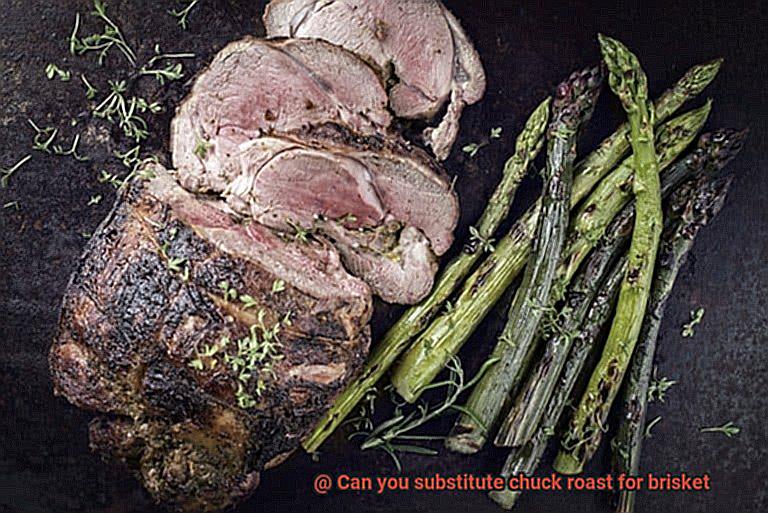
Choose the Right Cut:
To ensure a moist and tender chuck roast, look for one that is well-marbled with fat throughout. The fat will help keep the meat juicy during the cooking process. Look for chuck roasts with adequate marbling in the meat as it adds both flavor and tenderness.
Season Generously:
Just like brisket, chuck roast benefits from a good seasoning. Create a flavorful rub or marinade using spices such as salt, pepper, garlic powder, onion powder, and other herbs. Make sure to evenly coat the entire surface of the chuck roast with the seasoning.
Cook Low and Slow:
Low and slow is the key to success when cooking chuck roast as a substitute for brisket. Smoking, braising, or slow roasting are all great methods to achieve tender and juicy results. The slow cooking allows the tough connective tissues in the meat to break down, resulting in a more tender outcome.
Smoking Tips:
If you choose to smoke your chuck roast, maintain a consistent temperature of around 225-250°F (107-121°C) and smoke for several hours until it reaches an internal temperature of 195-205°F (90-96°C). This will ensure that the connective tissue breaks down and the meat becomes tender and flavorful.
Braising Tips:
For braising, sear the chuck roast on all sides in a hot skillet before transferring it to a Dutch oven or slow cooker. Add your choice of liquid, such as beef broth, red wine, or barbecue sauce, along with aromatics like onions, garlic, and herbs. Cover and cook on low heat for several hours until the meat is fork-tender.
Resting Is Key:
After cooking, allow the chuck roast to rest for at least 15-30 minutes before slicing or shredding. This resting period allows the juices to redistribute throughout the meat, resulting in a more flavorful and moist end result.
8c90uiKloYc” >
Conclusion
Yes, you can absolutely substitute chuck roast for brisket in certain recipes. While they may not be identical cuts of meat, chuck roast can provide a similar taste and texture when cooked properly. The key is to understand the differences between the two cuts and make adjustments accordingly.
Chuck roast comes from the shoulder area of the cow, while brisket is taken from the chest or breast region. Brisket is known for its rich marbling and deep flavor, making it a popular choice for barbecue and slow cooking methods. On the other hand, chuck roast has more connective tissue and requires longer cooking times to become tender.
When substituting chuck roast for brisket, keep in mind that you may need to adjust your cooking time and method. Since chuck roast has more connective tissue, it benefits from low and slow cooking techniques such as braising or slow roasting. This will help break down the collagen in the meat and result in a tender and flavorful final dish.
Additionally, consider marinating or seasoning your chuck roast with flavors that complement your recipe. This will enhance its taste and help mimic some of the smoky flavors typically associated with brisket.
While chuck roast can be a suitable substitute for brisket in many recipes, it’s important to note that there may be slight differences in taste and texture. However, with proper preparation and cooking techniques, you can still create a delicious meal that satisfies your craving for brisket.
In conclusion, if you find yourself without brisket but have a chuck roast on hand, don’t hesitate to give it a try as a substitute. With some adjustments to your cooking method and seasoning choices, you can achieve a mouthwatering dish that will impress your family and friends.

